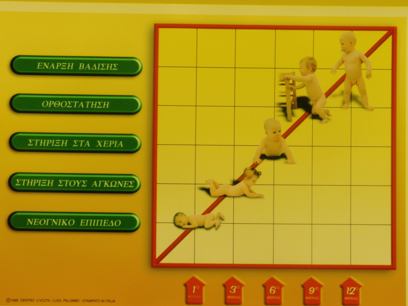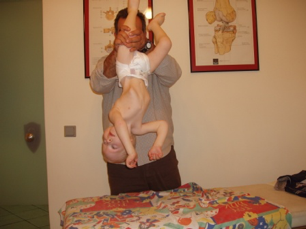Vojta
Contact
-
Adrianoupoleos 11A,
Kolonos, Greece
+30 210 51 29 504
Neurodevelopmental Kinesiological Diagnostics
The necessity of early diagnosis of motor disorders in neonates and infants has been repeatedly highlighted in the international literature.
The difficulty of assessing the neurological health of a newborn is confirmed not only by the significant number of neurological evaluation schemes proposed over the last 20 years but also by the presence of children with neurological conditions that could not be diagnosed at neonatal age.
Vojta Neurodevelopment Kinesiology Diagnosis is a neurological clinical test. It concerns new born, babies and infants. It can be done from the first day of the child's life, until he gets to his feet. In the early days of the newborn, kinetic damage is not established, and early diagnosis means early onset of Vojta physiotherapeutic treatment, aiming at exploiting the plasticity of the brain.
Early diagnosis, when followed by early onset of Vojta therapy, has spectacular results in the rehabilitation of children with encephalopathies. The statistics published every year by the Vojta Center around the world, confirm that.
Vojta proposed a method consisting of 3 sections for the clinical examination of the development of the Central Nervous System:
1. Observation of the spontaneous mobility of the infant

The child from the day of his birth until he reaches the autonomous bipolar walk passes through various developmental stages. At each stage he takes distinctive positions in his body. The observation leads to the discovery of any deviations from the physiological and the extrapolation conclusions for the organization of the brain function according to the infant's age.
2. Check 7 challenging position reflexes
ΤPositional reflexes are the motor responses that are caused to the newborn by specific body position changes. The position reflexes are seven, one carries the teacher's name, but everything is modified by Vojta himself. The kinetic behavior of the limbs and the trunk shows the child's motor age, the central nervous system maturation, but also the possible pathology and type. They are sure drivers in diagnosing growth from neonatal age.
| Reflective Vojta
|
Reflective Peiper - Isbert
|
| Reflective Collis horizontal
|
Reflective Collis vertical
|
| Reflective suspension from the armpits
|
Retro Reflection
|
| Reflective Landau
|
3. Control of primordial reflexes
It is a classic neurological pediatric control, but it has little diagnostic value due to its long residence time in the newborn. These remain for a long time until their staying as an indicator of pathology is considered and thus the advantage of early and early onset of treatment.
For example:
The reflex of conception (skin reflex) is released by placing our finger on the palm of the newborn, so it closes the fingers, capturing the object. There is from the day of birth until the operation of the support and the conception of the hand.

If left on the 5th - 6th month it means that there is a risk of a dyskinetic form and after the second trimester there is a risk of spasticity. This means we have to wait until the 6th month until we suspect the possible pathology of the child and then start treatment, resulting in valuable time being lost.

There are many studies that confirm the reliability of Vojta's diagnostics, with many of Dr Massao Tommi (Osaka, Japan) and Chung-Sik Chun in Korea.
With his (Diagnostic and Therapeutic) method, Vojta has opened a new path in the kinetic rehabilitation of this minority. The Vojta method shows the direction in the path of hope, which is to improve the kinetic state of people hit at an early age by neurological conditions.











